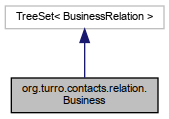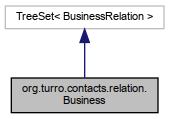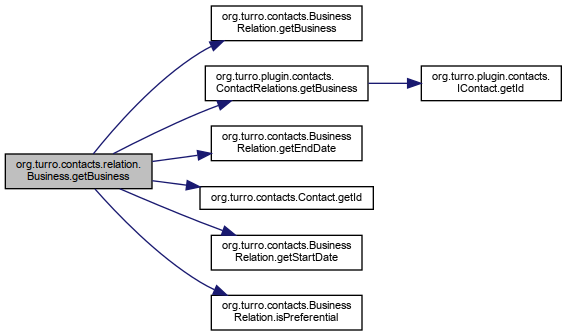- Author
- Lluis Turró Cutiller lluis.nosp@m.@tur.nosp@m.ro.or.nosp@m.g
Definition at line 39 of file Business.java.
◆ Business()
| org.turro.contacts.relation.Business.Business |
( |
Contact |
contact | ) |
|
Definition at line 44 of file Business.java.
45 this.contact = contact;
46 this.now =
new Date();
◆ getBusiness() [1/2]
| Contact org.turro.contacts.relation.Business.getBusiness |
( |
| ) |
|
◆ getBusiness() [2/2]
| Contact org.turro.contacts.relation.Business.getBusiness |
( |
Date |
date | ) |
|
Definition at line 54 of file Business.java.
55 for(BusinessRelation br :
this) {
56 if(br.isPreferential() && Dates.inRange(br.getStartDate(), br.getEndDate(), date)) {
57 return br.getBusiness();
60 for(IContactRelation cr : ContactRelations.getBusiness(contact.
getId(), ContactRelations.MODE_OUTER)) {
61 if(cr.getStrong() && cr.asWorker()) {
62 return getDao().find(Contact.class, cr.getRelatedId());
65 for(BusinessRelation br :
this) {
66 if(Dates.inRange(br.getStartDate(), br.getEndDate(), date)) {
67 return br.getBusiness();
◆ getBusinessList() [1/2]
| List<Contact> org.turro.contacts.relation.Business.getBusinessList |
( |
| ) |
|
◆ getBusinessList() [2/2]
| List<Contact> org.turro.contacts.relation.Business.getBusinessList |
( |
Date |
date | ) |
|
Definition at line 107 of file Business.java.
108 ContactList cs =
new ContactList();
109 for(BusinessRelation br :
this) {
110 if(Dates.inRange(br.getStartDate(), br.getEndDate(), date)) {
111 cs.add(br.getBusiness());
◆ getBusinessRelation() [1/2]
◆ getBusinessRelation() [2/2]
| BusinessRelation org.turro.contacts.relation.Business.getBusinessRelation |
( |
Date |
date | ) |
|
Definition at line 77 of file Business.java.
78 for(BusinessRelation br :
this) {
79 if(br.isPreferential() && Dates.inRange(br.getStartDate(), br.getEndDate(), date)) {
83 for(BusinessRelation br :
this) {
84 if(Dates.inRange(br.getStartDate(), br.getEndDate(), date)) {
◆ getCentersList()
| List<Contact> org.turro.contacts.relation.Business.getCentersList |
( |
| ) |
|
Definition at line 97 of file Business.java.
99 .filter(c -> ContactType.CONTACT_LEARNINGCENTER.equals(c.getType()))
100 .collect(Collectors.toList());
◆ getCompaniesList()
| List<Contact> org.turro.contacts.relation.Business.getCompaniesList |
( |
| ) |
|
Definition at line 91 of file Business.java.
93 .filter(c -> ContactType.CONTACT_COMPANY.equals(c.getType()))
94 .collect(Collectors.toList());
◆ getCoworkers() [1/2]
| List<Contact> org.turro.contacts.relation.Business.getCoworkers |
( |
| ) |
|
◆ getCoworkers() [2/2]
| List<Contact> org.turro.contacts.relation.Business.getCoworkers |
( |
Date |
date | ) |
|
Definition at line 135 of file Business.java.
136 ContactList cs =
new ContactList();
137 for(BusinessRelation br :
this) {
138 Workers workers =
new Workers(br.getBusiness());
139 cs.addAll(workers.getWorkers(date));
◆ getOutdatedList() [1/2]
| List<Contact> org.turro.contacts.relation.Business.getOutdatedList |
( |
| ) |
|
◆ getOutdatedList() [2/2]
| List<Contact> org.turro.contacts.relation.Business.getOutdatedList |
( |
Date |
date | ) |
|
Definition at line 121 of file Business.java.
122 ContactList cs =
new ContactList();
123 for(BusinessRelation br :
this) {
124 if(!Dates.inRange(br.getStartDate(), br.getEndDate(), date)) {
125 cs.add(br.getBusiness());
The documentation for this class was generated from the following file:



